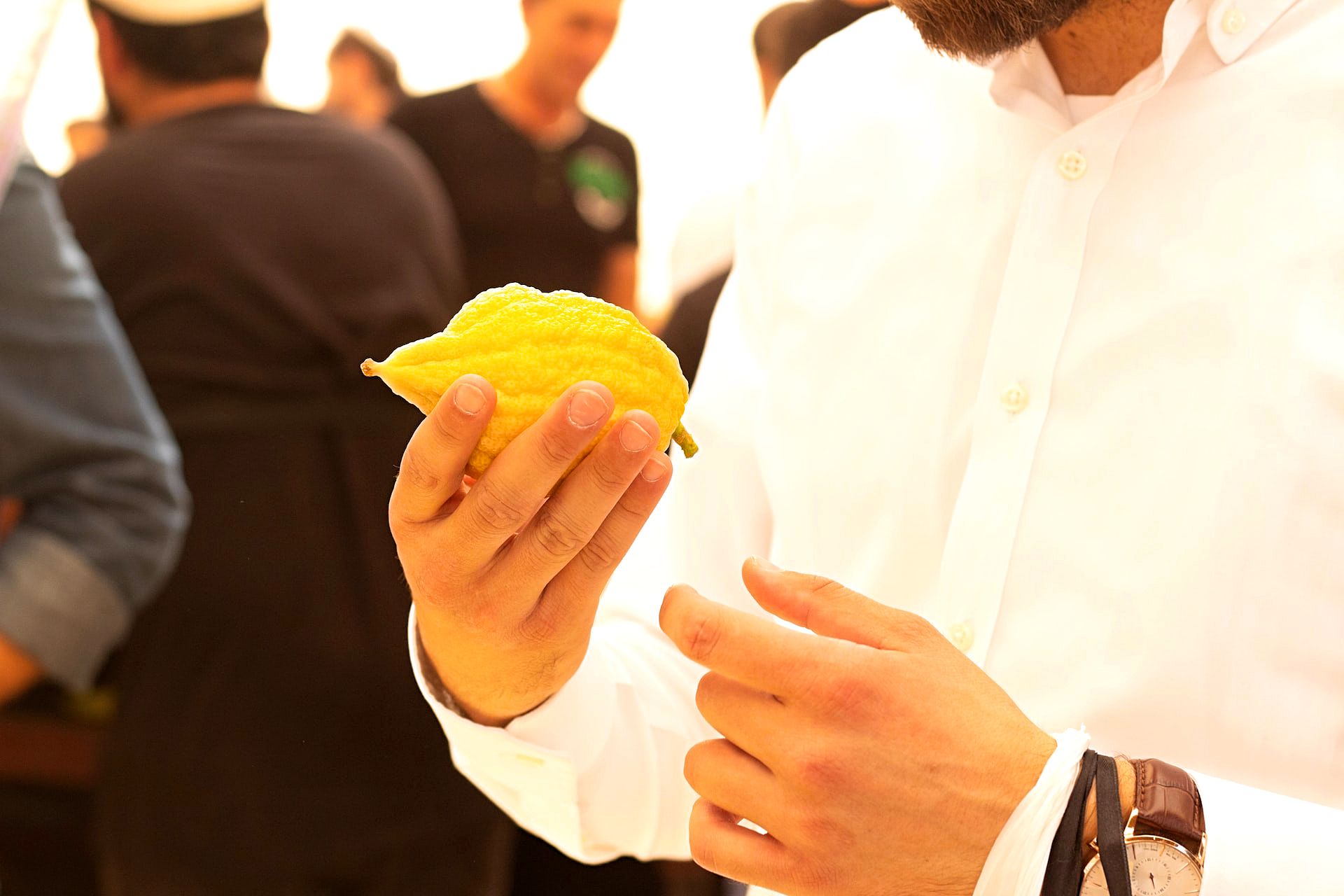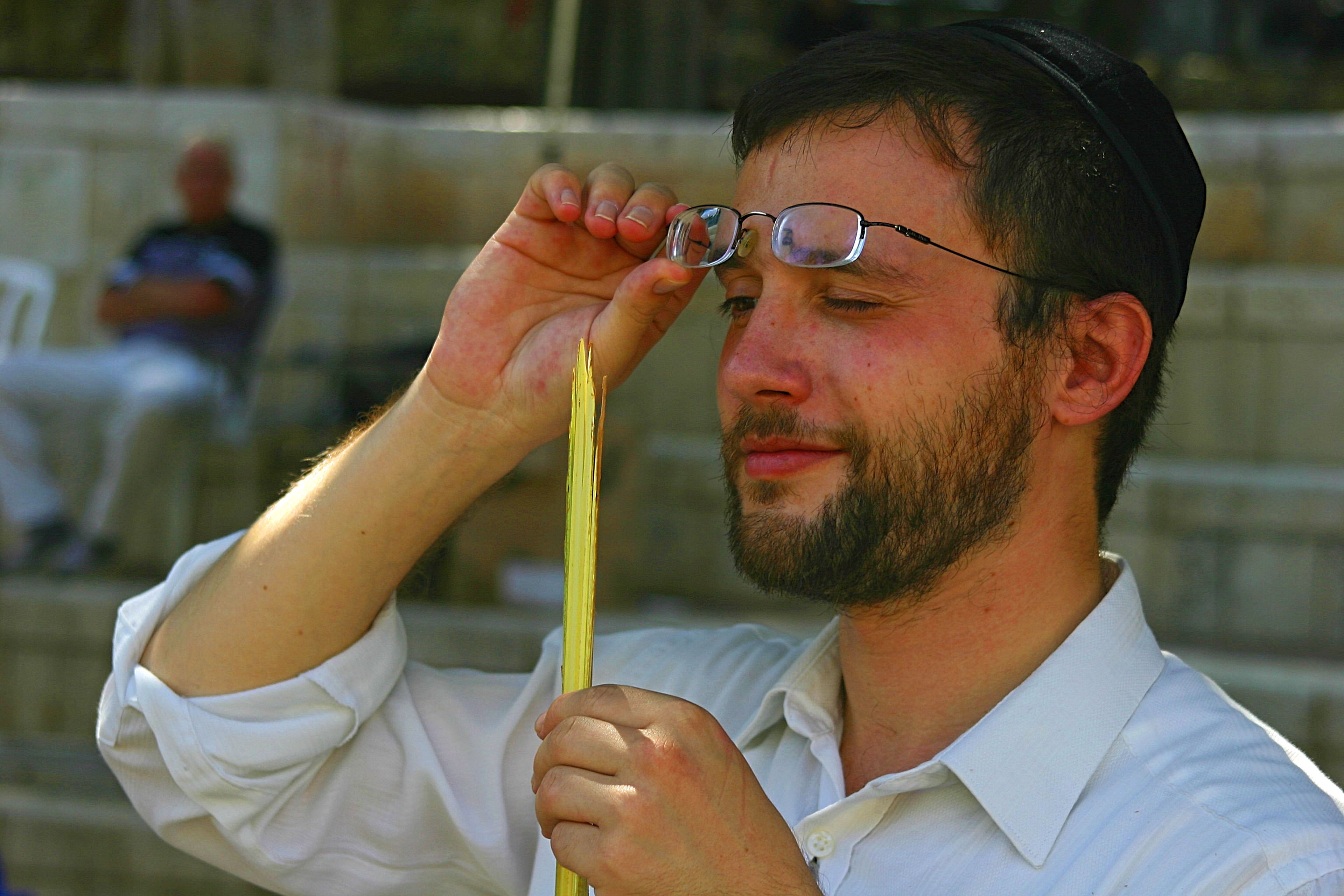Sukkot in Israel
Welcome to our series of blogs on the Jewish ‘High Holidays’ which, arguably, are the most attended holidays in the Jewish calendar. They last for a period of almost three weeks, and although they do not run consecutively the run-up to them is a very busy time in Israel.

A man chooses an etrog in Sukkot, the four species. Photo by Esther Wechsler on Unsplash
First, as we wrote previously, there’s Rosh Hashanah - the Jewish New Year - and in Israel this is celebrated for two days, beginning and ending at nightfall. Ten days later, is the most solemn day of the year, Yom Kippur. Also known as the Day of Atonement, Yom Kippur is a chance for Jews to reflect, pause, and atone for their sins - Orthodox Jews fast for 25 hours and all public life in Israel (including flights, public transport, and even drivers on the road) ceases, even in the usually vibrant city of Tel Aviv.
The next, and one that is much-loved, is the one we are looking at today - Sukkot. Unlike Yom Kippur, this is a cheerful holiday, lasting for a week, and is really a chance for Jews to ‘give thanks’ for things often taken for granted, such as shelter and food. Let’s take a closer look at this holiday and what it entails…
When does Sukkot begin? What does Sukkot mean?
Sukkot begins five days after Yom Kippur, on the fifteenth day of Tishrei. In the Gregorian calendar, this means it falls sometime between September and October. What does Sukkot mean? ‘Sukkot’ in Hebrew means ‘booths’ and remembers the booths (temporary shelters) that the Israelites built to protect themselves when they were wandering in the wilderness for 40 years, after their exodus from Egypt and freedom from slavery under the Pharaoh.
What is the main theme of Sukkot?
Sukkot is one of Judaism’s three ‘pilgrimage festivals’ (the other two being Passover and Shavuot). Historically, this was a time when Jews were able made a ‘pilgrimage’ to the Temple in Jerusalem. The main ‘theme’ of this holiday is thankfulness and ‘togetherness’, thanking God for the harvest and also for deliverance from Egypt, and spending time with loved ones. The other biblical theme is that Sukkot marks the completion (and new beginning) of the annual Torah reading, of which a portion is read every week in the synagogue.

Hasidic Jew at the Western Wall, Jerusalem. Photo by Joshua Sukoff on Unsplash
Why do Jews build booths in their home at this time of the year?
Yes! It really is. It’s an amazing sight, especially in Israel, where not only do people put up booths (sukkot) in their homes - on balconies usually - but also in the streets, and in restaurants! It’s a great activity for children too - building a ‘sukkah’ (sukkot is plural) is something every youngster looks forward to, because it’s a chance to get creative, not to mention live a bit differently for a week. It is customary to build your sukkah soon after Yom Kippur, even though there are few days remaining before Sukkot begins.
What do the booths look like?
No sukkah ever looks the same in Israel (which is why this holiday is so special) and no space is too small to build a sukkah in! Even if you don’t have a patio, a balcony will do. The important ‘rule’ when building is that your structure needs to be temporal i.e impermanent. It needs to have at least three walls but - usually - the roof is made out of branches of trees, or reeds.
What is Important: all (or at least part) of its roof should be open to the sky - after all, it is a dwelling not meant to last! Many people hang seasonal fruits from the roofs of their sukkah (think apples, grapes, pomegranates) to thank God for nature's gifts. Some children love fairy lights and draw cards and paintings. (Warning: be careful with the fairy lights - you don’t want to inadvertently start a fire!)
What do you do in a Sukkah?
It’s traditional to eat your meals in the sukkah and some very Orthodox Jews may even sleep in it (although in colder countries this is not advisable, since you could end up with pneumonia!) You can also rest in one, read a book, hang out with friends, and have nightly celebrations with live music.

The citrons at the Festival of the Booths, known also as Tabernacle. Photo by al-ex via FreeImages
What are the ‘four species’ of Sukkot?
Excellent question! If you’re visiting Israel at this time of the year, you’ll see these four species being sold in markets and stores, in the run-up to the holiday. The four species (‘arba’at ha-minim’ in Hebrew) are the lulav, the etrog, the myrtle, and the willow. These are all mentioned in the Torah (the Hebrew Bible) as being associated with Sukkot and the waving of the four of them is considered to be a commandment, by observant Jews. Tell me more about the lulav, etrog, myrtle, and palm…
Historically, these four species were all waved in the Temple at Jerusalem for all seven days of the festival. The lulav is a cluster of plants - one palm, two bouts of willow, and three of myrtle. The etrog is a citron (not quite like a lemon, but with some similarities). Together, they make up the four species, and, for ritual purposes, the etrog is held in the left branch and the palm branch (intertwined with the willow and myrtle) in the right.
What happens in the synagogue at Sukkot?
Sukkot is an incredibly joyous occasion. In stark contrast to the solemnity of Kippur, this is a time of celebration. In synagogues across Israel (and all over the world) the Torah scrolls are taken out of the Ark and congregants parade around the sanctuary - men, women, and children alike.
There’s great merriment, with singing and dancing and all of this is a reminder that, in life, we should always take a little time each day to be happy and thankful for our wonderful world. After all, every day is precious but life is also fragile and - like the booths in which meals are eaten - temporal.
On the seventh day of Sukkot, the four species (talked about above) are carried around the synagogue seven times. During certain Psalms (Hallel), Jews wave them up and down and forward the four points of the compass. This is an indication that God is everywhere - and also omnipotent.

Lulav, one of the 4 species of plants for Sukkot. Photo by al-ex via FreeImages
What foods are commonly eaten at Sukkot?
There’s no one particular food that Jews are commanded to eat (at Passover, there’s a seder plate, and at Shavuot one always eats dairy products) but since Sukkot is a harvest festival, many fruits and vegetables will appear on the table! Expect to see carrots, squash, zucchini, and the like, as well as fruits like apples.
Some people, in a symbol associated with the ‘abundance’ of harvest, may serve vegetables that are stuffed - peppers, cabbage, and grape leaves, for instance. Moreover, there will always be ‘traditional’ Jewish foods on the table, such as matzah ball soup, roast chicken, and - of course - the lovely slightly-sweet challah bread that is eaten every Friday night, on the Jewish Shabbat.
Is visiting Israel over Sukkot popular?
It’s an incredibly popular time of the year for visitors - not just Jews, who want to eat in kosher restaurants with sukkahs, but anyone who wants a beach holiday, because the weather is still so good in Israel. The only thing to note is that it can be very crowded because Israeli children are on holiday this week - this means that families will be traveling around Israel, so national parks, nature reserves, and museums will all be very busy.

A religious Jew chooses an etrog for Sukkot. Photo by al-ex via FreeImages
On the other hand, it’s a great chance to see Israelis out and about and having fun, and - as noted before - weather-wise it is perfect. You can enjoy lots of sun without having to escape the heat of the Israeli summer, and the chances are you will see no rain either - that does not usually arrive until November.Can I take an organized tour around Israel over Sukkot?
Absolutely. In fact, because public transport is so crowded, it can be an excellent idea to take an organized tour or day trip around Israel - this means you’ll travel around in a comfortable (and air-conditioned bus) and have the services of a professional guide, as well as entrance fees and tickets for attractions being bought beforehand for you, so you don’t have to waste time standing in line.
So if you want to explore the holy sites in Jerusalem or churches of Galilee, float at the lowest point on earth at the Dead Sea or take a food tour at Tel Aviv’s Carmel Market, get in touch with us - by phone or email. We’ve been in business for over 35 years and guarantee you an experience you’ll never forget. Also, feel free to take a look at our blog, if you want more ideas about where to visit or just to get an overview of life in the Holy Land. Happy holidays to you all!

The Judean Desert from the Masada Cable Car, Israel. Photo credit: © Shutterstock
 Login / Register
Login / Register
 Contact Us
Contact Us
 Certificate of Excellence
Certificate of Excellence Guaranteed Departure
Guaranteed Departure Low Prices Guaranteed
Low Prices Guaranteed 24/7 Support
24/7 Support




